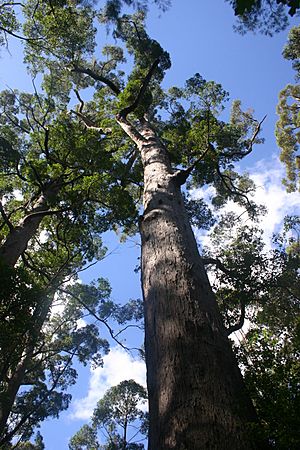Red tingle facts for kids
Quick facts for kids Red tingle |
|
|---|---|
 |
|
| Red tingle in the Valley of the Giants | |
| Scientific classification | |
| Genus: |
Eucalyptus
|
| Species: |
jacksonii
|
The red tingle (scientific name: Eucalyptus jacksonii) is a very tall tree found only in the southwest part of Western Australia. It's one of the tallest trees in that state! This amazing tree has thick, rough, reddish bark that covers its trunk and even its smallest branches. Its leaves are shaped like eggs or spears. It produces white flowers and round or barrel-shaped fruits.
Contents
What is a Red Tingle Tree Like?
The red tingle tree is a giant, usually growing between 8 and 45 meters (about 26 to 148 feet) tall. It has thick, rough bark that can be grey-brown or red-brown. The base of very old trees can be huge, sometimes up to 24 meters (about 79 feet) around! While some people say they can reach 75 meters, the tallest known living red tingle is about 52 meters (171 feet) tall.
Leaves, Flowers, and Fruit
The top part of the tree, called the crown, is very thick and leafy. Young red tingle plants have large, egg-shaped leaves that are dark green on top and lighter underneath. These leaves are about 12 to 17 centimeters (5-7 inches) long and 6 to 10 centimeters (2-4 inches) wide.
Adult leaves are smaller, about 6 to 9.5 centimeters (2-4 inches) long and 1.2 to 2.5 centimeters (0.5-1 inch) wide. They are also dark green on top and paler below.
The flowers of the red tingle are white and grow in groups of seven. They bloom between January and March. After flowering, the tree produces woody, round, or barrel-shaped fruits.
Roots and Wood
Red tingle trees often have shallow roots. Their bases can become very wide and strong, like a support. The wood inside the tree is a deep pink to reddish-brown color.
One famous red tingle tree is called the "Giant Tingle Tree." It's a popular spot for tourists in the Walpole-Nornalup National Park. Its base is hollowed out by fire, and people say it has the largest trunk size of any living eucalyptus tree.
How Red Tingle Trees Are Related to Other Trees
The red tingle is often compared to two other types of tingle trees: the yellow tingle (Eucalyptus guilfoylei) and Rate's tingle (Eucalyptus brevistylis). The red tingle is much taller than these two. It is most closely related to Rate's tingle.
Naming the Red Tingle
The red tingle was first officially described by a botanist named Joseph Maiden in 1914. He named the species Eucalyptus jacksonii after Sidney William Jackson. Sidney Jackson was an Australian naturalist and bird expert who collected the first samples of this tree.
Where Red Tingle Trees Live
Over millions of years, the area where red tingle trees grow has become smaller because of changes in the climate. Today, you'll mostly find them in the Walpole-Nornalup National Park. You can also find a few groups of them outside the park in the Walpole area. They grow on hillsides and in valleys where the soil is loamy (a mix of sand, silt, and clay).
These trees often grow alongside other well-known Australian trees like Eucalyptus marginata (jarrah), Eucalyptus diversicolor (karri), and Corymbia calophylla (marri). Red tingles can also be found with yellow tingles and Rate's tingles. When they grow together, the red tingles are usually the most common and tallest trees in the forest.
Images for kids
-
Tingle tree crown in Walpole-Nornalup National Park
See also
 In Spanish: Eucalyptus jacksonii para niños
In Spanish: Eucalyptus jacksonii para niños






